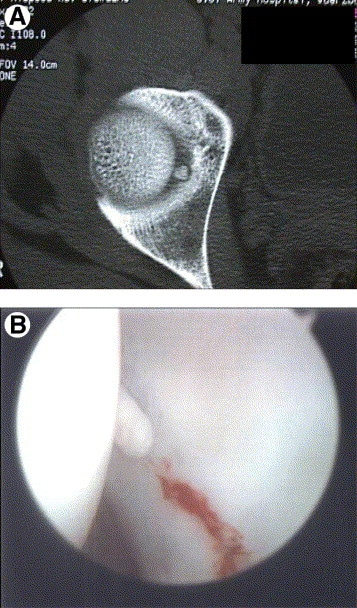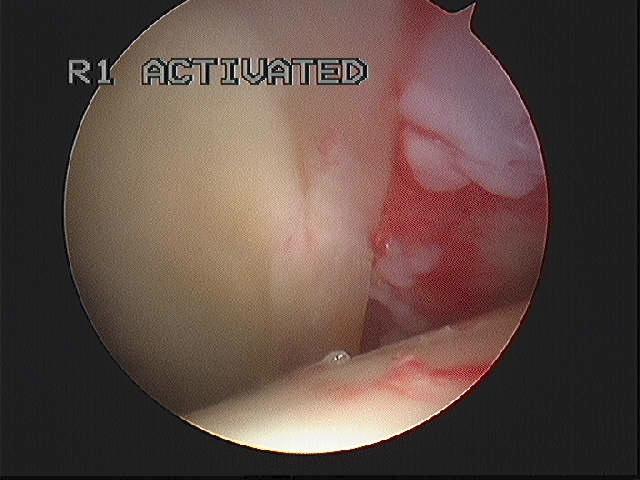The hip, like any other joint in the body, can be affected by loose bodies. These loose bodies may be cartilaginous or bony, but are most often a combination of both – these are referred to as osteochondral (osteo = a bony core and chondral = a cartilage surface) loose bodies.
There are a number of conditions that can lead to loose bodies forming within the hip joint. Traumatic dislocations of the hip can be associated with fractures of either the femoral head (ball) but more commonly of the edge of the acetabulum (socket) and as a result small fracture fragments can break off the joint surface and become loose and potentially trapped in the joint.
Figure 1. Loose Body seen A. on CT scan and B. at arthroscopy.
Osteoarthritis can be a cause of loose bodies – presumably osteophytes (bony spurs around the margins of the joint) break off and can become loose inside the hip. A somewhat unusual condition called osteochondritis dissecans can affect the joint surface and underlying bone of the femoral head (ball) of the hip. In its advanced stages a small part of the surface can detach and float free in the hip. In a condition called synovial osteochondromatosis – multiple and sometimes hundreds of small loose bodies can arise like “mushrooms” from the synovial lining of the hip and are shed into the joint.
Loose bodies can vary in size from tiny to very large and their size tends to dictate what kinds of problems they can cause. Small loose bodies may cause no trouble at all, mid size ones tend to float/move around inside the joint and can get stuck from time to time causing intermittent locking or jamming of the hip. Very large loose bodies frequently can’t move around freely in the joint but in some circumstances can restrict movement in a similar way to hip impingement conditions.
Symptomatic loose bodies of the hip are best treated by removal – either by open operation (for very large loose bodies) or by arthroscopic (minimally invasive) means in most cases. It is also important to treat any joint surface defect associated with the origin of the loose body. Definitive treatment of loose bodies associated with synovial osteochondromatosis is almost impossible because new bodies will tend to form again with time. Synovectomy of the hip may address this problem but it is difficult to remove all synovial tissue from the hip because of its complex joint geometry.
Figure 2. Soft chondral loose bodies attached to the synovial lining of the hip in synovial osteochondromatosis.
Source : https://www.parkclinic.com.au/loose-body-of-the-hip/


